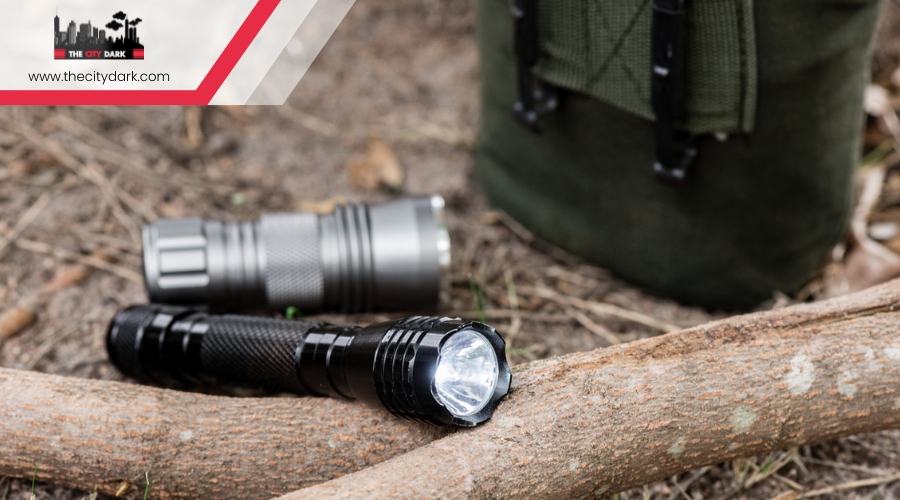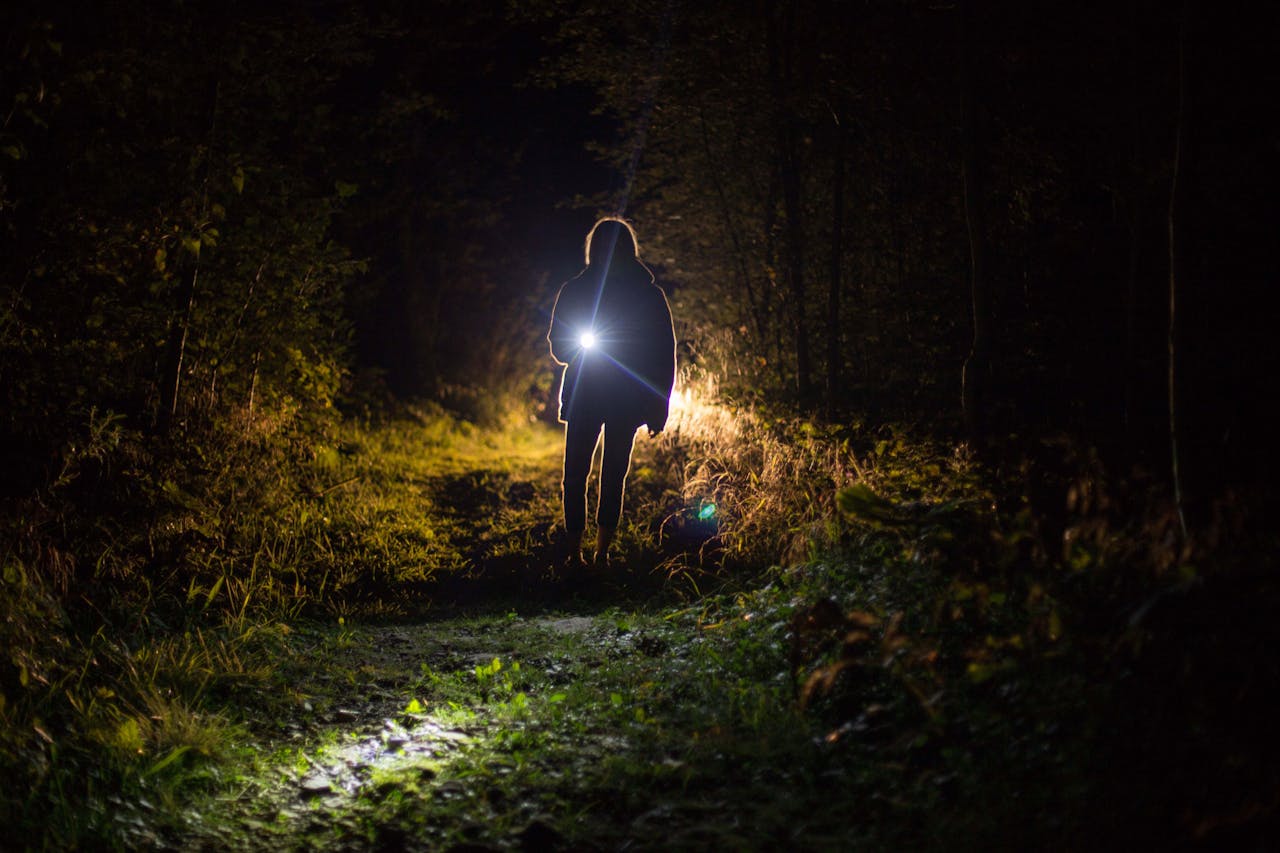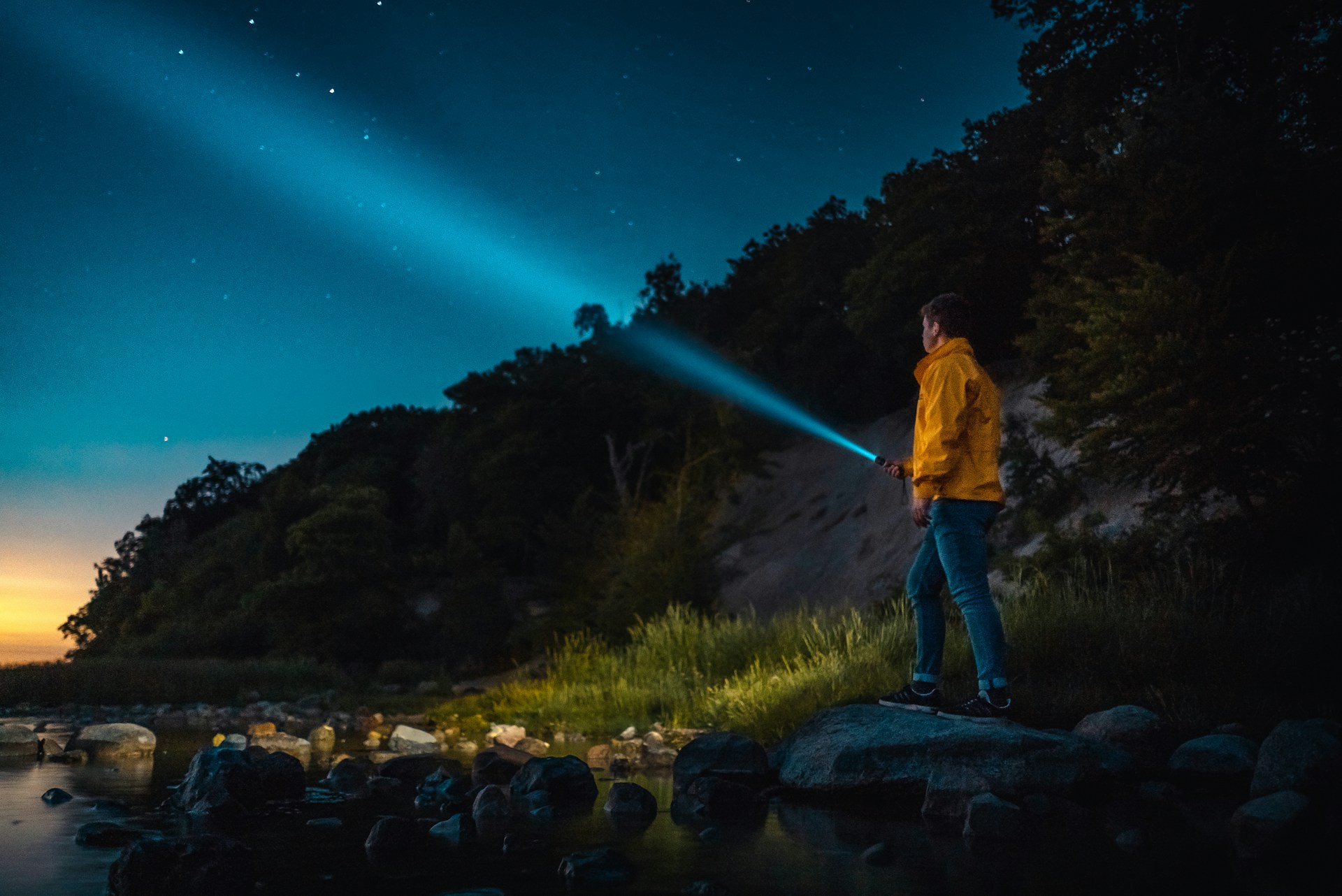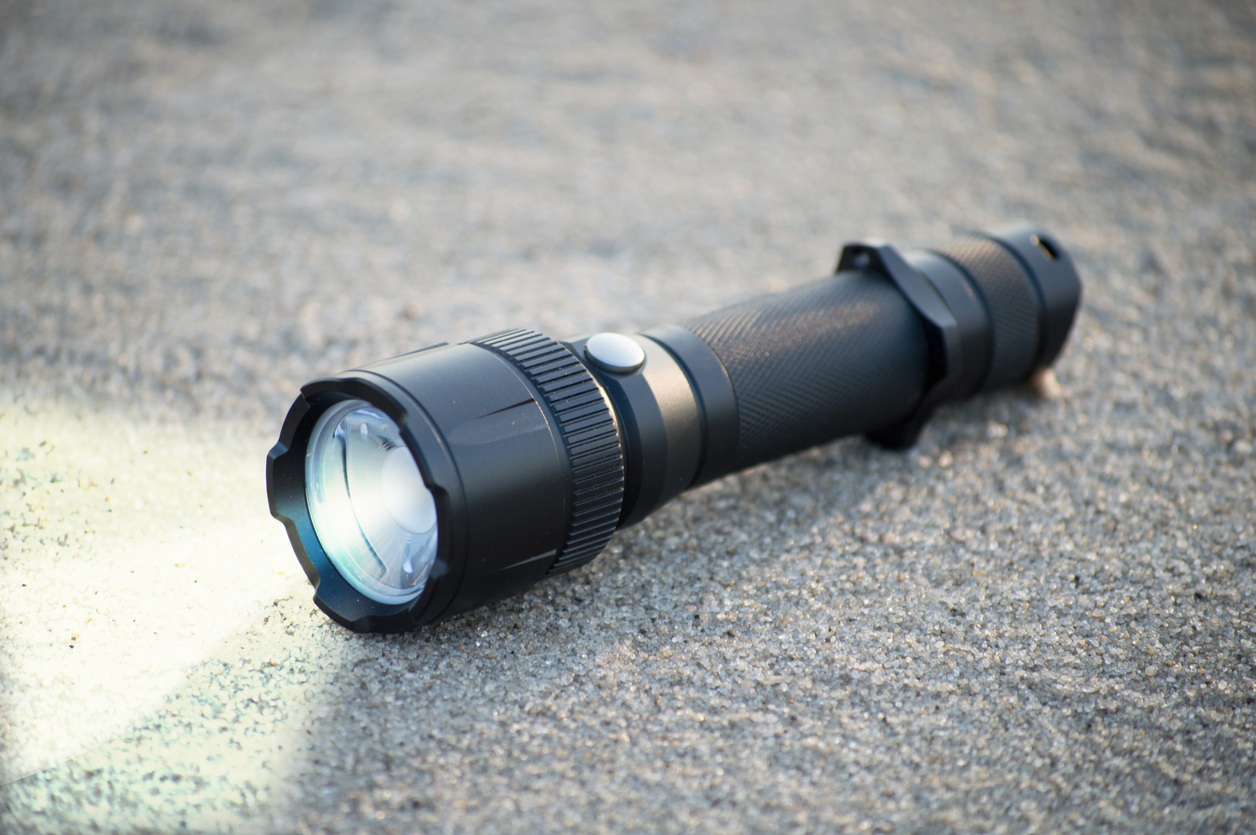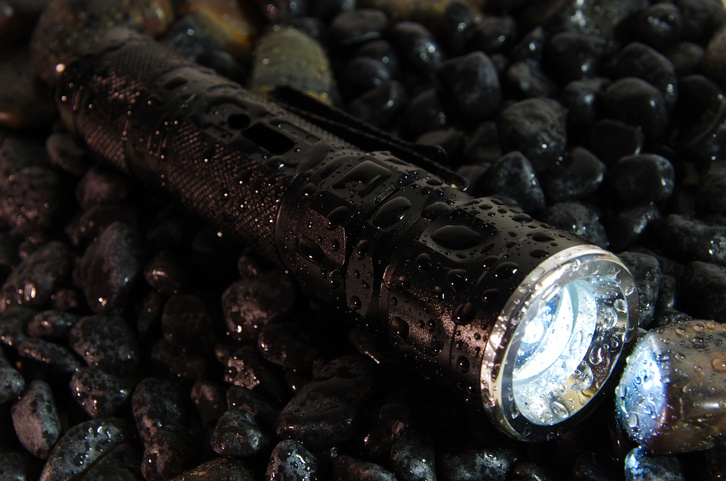In the calm of your home, a flashlight might just be another tool in the drawer; however, in the unpredictability of the wilderness, it becomes your beacon of safety. You’re embarking on a journey where the right gear can mean the difference between comfort and peril.
A flashlight ideal for wilderness survival isn’t just about shedding light in the dark; it’s about ensuring you can navigate the untamed paths, signal for help, and even deter wildlife. As you equip yourself for the unknown, consider how features like durability, beam distance, battery life, and emergency functions transform a simple flashlight into a survival tool.
Let’s explore what sets these indispensable gadgets apart, ensuring you’re never left in the dark when adventure calls.
Key Takeaways
- Prioritize durability and ruggedness when selecting a flashlight for wilderness survival.
- Look for flashlights that are both water and impact resistant.
- Consider the battery life and rechargeability options of the flashlight.
- Understand the importance of lumens, beam distance, and light modes for navigating and exploring in the dark.
Durability and Ruggedness
When considering a flashlight for wilderness survival, it’s crucial to prioritize durability and ruggedness. You’re stepping into an environment where your gear’s ability to withstand tough conditions can make the difference between thriving and merely surviving. Look for a flashlight made from materials that laugh in the face of impact and harsh conditions. You need something that won’t crack under pressure or flicker out when you need it most.
Opt for waterproof and shock-resistant flashlights. These are non-negotiable features when you’re facing the unpredictability of the great outdoors. You might find yourself in the middle of a downpour or accidentally drop your light on a rocky trail. In these moments, a durable and rugged flashlight isn’t just helpful; it’s essential.
Ensure the flashlight you choose has reliable construction. This isn’t about having a fancy gadget but securing a tool that won’t fail you in critical situations. A reliable flashlight is your beacon in the dark, guiding you through the night or signaling for help. Remember, in the wilderness, your survival might just hinge on the durability and ruggedness of your flashlight.
Water and Impact Resistance
In the face of unpredictable weather and rough terrains, it’s essential that your survival flashlight is both water and impact resistant. These features ensure that your light source remains reliable in any emergency situation.
A survival flashlight with water resistance allows you to navigate through rainy conditions and wet environments without the fear of damage. Whether you’re crossing a stream or caught in a downpour, your flashlight’s performance won’t be compromised.
Moreover, impact resistance is a non-negotiable when it comes to selecting a survival tool. Your flashlight needs to withstand accidental drops and rough handling, common occurrences in the wilderness. This durability is a testament to the flashlight’s construction quality and its ability to serve you in the most challenging situations.
When choosing your survival flashlight, pay close attention to high IPX ratings for water resistance and seek out models known for their sturdy build. These characteristics are indicative of a flashlight’s capability to endure the elements and rough use.
Ultimately, a flashlight equipped with water and impact resistance isn’t just a tool; it’s a lifeline in outdoor survival and emergency situations.
Battery Life Considerations
Assessing your flashlight’s battery life is crucial for ensuring it remains a dependable source of light during wilderness adventures. You’ve got to weigh the pros and cons between using rechargeable or disposable batteries. High-quality rechargeable batteries offer longer runtimes and the convenience of recharging, potentially saving you from a power outage at the worst possible time. Plus, choosing flashlights with USB-C charging can add that extra layer of convenience, making it easier to power up with the same cable you use for other devices.
It’s also wise to look for a flashlight with a battery regulator. This feature helps manage power output, ensuring consistent lighting even as the battery drains, which is crucial for maintaining visibility in the wilderness. Balancing battery life with brightness settings is key; you’ll need to consider what you’re up against in the wild to make the right choice.
Lastly, for those long hauls away from civilization, think about bringing along a small battery charger if you’re leaning towards rechargeables. However, don’t dismiss the value of disposable batteries. They can be a real lifesaver for extended stays in the wilderness where recharging options are nil.
Lumens and Beam Distance
When you’re selecting a flashlight for wilderness survival, understanding the importance of lumens and beam distance is key. Lumens tell you how bright the flashlight is, while the beam distance shows how far the light reaches, both crucial for navigating and exploring in the dark.
Choosing the right balance can make all the difference in meeting your specific outdoor needs.
Understanding Lumens Importance
Understanding the importance of lumens and beam distance in a flashlight can significantly impact your ability to navigate and survey your surroundings effectively in the wilderness. Lumens measure the amount of light a flashlight emits. The higher the lumens, the brighter the light, and the longer the beam distance. This means you’ll see further and clearer, crucial for survival situations.
Beam distance, how far the light reaches, is vital for spotting distant landmarks or hazards. It’s not just about having the brightest flashlight; it’s about finding the right balance of lumens and beam distance for your specific needs.
Whether you’re navigating dense forests or signaling for help, understanding these aspects ensures you’re better equipped for any survival scenario.
Beam Distance Explained
To effectively navigate the wilderness at night, you’ll need to grasp the concept of beam distance, which is directly influenced by a flashlight’s lumens output. Lumens measure the total visible light a flashlight emits, while beam distance indicates how far that light reaches. The relationship between these two factors is crucial for wilderness survival.
A higher lumens count usually means a longer beam distance, letting you see farther ahead. However, for close-up tasks, a blindingly bright light isn’t always best. It’s essential to understand this balance when selecting a flashlight for different scenarios.
Knowing how lumens and beam distance work together will ensure you choose a flashlight that meets your specific needs in the wilderness.
Optimal Lumen Range
Selecting the right flashlight for wilderness survival hinges on finding the optimal lumen range, balancing adequate illumination for tasks without overwhelming your vision. You’ll want a flashlight that offers enough light to manage basic tasks and survey your surroundings. However, too much light can make close objects hard to see, so striking a balance is crucial. Look for a model where you can adjust the brightness based on your specific situational needs.
Considering the battery life is essential, especially in survival situations where power sources are scarce. Opt for a USB-C rechargeable flashlight to ensure you can easily recharge it with a power bank or solar charger. This feature not only saves you from carrying extra batteries but also ensures your flashlight is ready when you need it most.
Light Modes and Functions
As you navigate through the wilderness, the ability to adjust your flashlight’s brightness levels becomes indispensable. Not only does it conserve battery life, but it also ensures you’ve got the right amount of light for any situation, be it navigating trails at dusk or reading maps in the dark.
Furthermore, having emergency signal features on your flashlight can be a lifeline in survival scenarios, making it easier to signal for help when in distress.
Adjustable Brightness Levels
Adjustable brightness levels, featuring various light modes and functions, are crucial for efficiently managing different tasks and conserving battery life in the wilderness. Whether you’re reading maps at night, signaling for help, or navigating tricky terrain, the ability to switch between brightness levels ensures you’ve got just the right amount of light.
You don’t want to overpower your surroundings with max power when a lower output would suffice. These varied light modes, from a gentle glow for preserving your night vision to a high-intensity beam for emergency signals, provide the flexibility you need.
Emergency Signal Features
In wilderness survival situations, a flashlight equipped with emergency signal features like strobe and SOS modes can be a lifesaver, drawing attention when you need it most. These features are crucial in emergency preparedness, making your survival light not just a source of illumination, but a tool for rescue.
- Strobe mode: A rapid flashing light that’s perfect for signaling your location to rescuers or for disorienting potential threats.
- SOS mode: Sends a universal distress signal using Morse code (···—···), essential for attracting help without needing verbal communication.
- Adjustable brightness: Helps conserve battery life, ensuring that your light stays on longer, which is vital during prolonged survival situations.
Understanding and using these light modes and functions enhance your safety and survival chances in the wilderness.
Size and Weight
When choosing a flashlight for wilderness survival, it’s crucial to consider its size and weight to ensure it’s easy to carry without burdening your gear. The best flashlight for these scenarios strikes a perfect balance between being lightweight and compact, yet powerful enough to meet your lighting needs. You don’t want a flashlight that’s cumbersome or adds unnecessary weight to your pack, especially in situations where mobility is key and every ounce counts.
Opting for a flashlight that’s easy to carry means you’re more likely to have it on you when you need it most. Look for models that offer the illumination you require without weighing you down or taking up too much space. A smaller, lighter flashlight can be a game-changer in the wilderness, providing convenience without sacrificing performance.
Rechargeability Options
When you’re out in the wilderness, the ability to recharge your flashlight is crucial. Solar charging capabilities mean you’re never without power as long as the sun’s out.
Meanwhile, USB power sources allow you to quickly juice up your light using a portable battery or even your car.
Solar Charging Capabilities
Harnessing the power of the sun, solar charging capabilities offer you a renewable way to keep your flashlight powered in the wilderness without relying on disposable batteries. This option not only makes it easy to find a sustainable power source but also ensures your flashlight remains functional when setting up camp or navigating through remote areas. Solar charging capabilities provide a dependable solution, freeing you from the limitations of traditional power sources and contributing to an environmentally friendly outdoor experience.
- Solar panels allow for easy power replenishment in remote locations.
- Offers independence from conventional power sources, enhancing reliability.
- Environmentally friendly, reducing the need for disposable batteries and minimizing waste.
USB Power Sources
In addition to solar charging capabilities, USB power sources offer another layer of convenience and sustainability for keeping your flashlight powered in the wilderness. You’ll find that a tactical flashlight equipped with USB power sources, particularly USB-C, significantly cuts down on waste and cost by eliminating the need for disposable batteries.
These rechargeability options don’t just save you money; they’re also about ensuring you’ve got a reliable light source for longer. With faster charging times, you’re back to exploring or navigating in no time.
Many tactical flashlights now come with built-in rechargeable batteries as an additional feature, providing you with a dependable power source essential for any wilderness survival situation.
Materials and Construction
Selecting a survival flashlight? Start by considering its materials and construction, as these factors directly impact its durability and reliability in the wild. The right flashlight should withstand rugged outdoor conditions without weighing you down. Here’s what you need to keep an eye out for:
- Durable, Lightweight Materials: Your flashlight’s build is crucial. Opt for one made from materials that are both strong and light. This ensures it’s easy to carry without compromising on toughness.
- Waterproof and Shock-Resistant Construction: The wilderness is unpredictable. Your flashlight must endure not just the elements but also accidental drops and bumps. Look for features that guarantee it’ll work in wet conditions and after unexpected impacts.
- Convenience Features: A pocket clip and lanyard can make a big difference. They keep your flashlight readily available, so you’re never left fumbling in the dark. Additionally, a firm grip is essential. It ensures you can hold onto your light securely, even in the most challenging conditions.
Materials and construction aren’t just about durability; they’re about making your survival tool easy to use and readily available when you need it most.
Emergency Features
After considering the importance of materials and construction, let’s focus on the emergency features that can make a survival flashlight truly indispensable. One critical feature is the SOS mode, designed specifically for signaling in emergency situations. This mode can be a lifesaver, ensuring you’re visible to rescuers even from a distance.
Equally important is the strobe mode, not just for signaling, but also for self-defense. In the wilderness, you might encounter threats from wildlife or, less commonly, other people. The disorienting effect of strobe light can give you the upper hand, allowing you to escape or prepare a defense.
You’ll also appreciate a flashlight that’s built to last in wet environments. A waterproof housing means you won’t be left in the dark during rainstorms or if you need to navigate waterways. Similarly, shockproof construction ensures your flashlight can withstand drops and impacts, which are inevitable in rugged conditions.
Lastly, compatibility with AA lithium batteries is a boon for cold weather survival. These batteries perform well even in freezing temperatures, ensuring your flashlight works for a long time without needing a replacement. Night vision mightn’t be directly enhanced, but ensuring your light stays on through the night is crucial.
Brand Reliability and Warranty
When choosing a survival flashlight, you can’t overlook the manufacturer’s reputation and the warranty offered. Brands like Warrior X are renowned for their brand reliability and robust warranty policies, making them a top choice for wilderness adventurers. Reliable brands ensure that your flashlight can withstand the unpredictable conditions of the wild, from heavy rain to accidental drops.
Here’s why brand reliability and warranty matter:
- Durability: Brands with a strong reputation, such as Warrior X, use higher quality materials and manufacturing processes, ensuring your flashlight lasts longer even under harsh conditions.
- Warranty Support: A comprehensive warranty offers peace of mind, knowing that if your flashlight fails due to manufacturing defects, you’re covered. It’s an indicator of the manufacturer’s confidence in their product.
- Customer Service: Reliable brands often provide superior customer service, helping you resolve any issues quickly, whether it’s a warranty claim or product advice.
Conclusion
In conclusion, when you’re gearing up for the wilderness, choosing the right flashlight is crucial. You’ll need one that’s tough, can handle a few knocks and doesn’t mind getting wet. Look for one with a long battery life, bright enough to light up your path, and a beam that reaches far.
Features like different light modes, rechargeability, and emergency signals can be lifesavers. Don’t skimp on quality; pick a reputable brand with a solid warranty. It’s your beacon in the wild.

